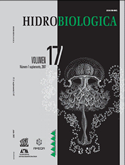Multimetric analyses for assessing pollution in the Lerma river and Chapala lake, Mexico
Keywords:
Multimetric analysis, biotic index, water quality, Mexico.Abstract
Techniques for monitoring the water quality should have low costs and consider several parameters in order to obtain more efficient analysis of data. This study proposes an application of a multimetric system for the bioassessment of the contamination during dry (May), rainy (July) and post-rainy conditions (November) in the main stream of the LermaChapala basin. It included seven physiochemical determinations for the Water Quality Index (WQI), an Extended Biotic Index (EBI) based on the macrobenthos communities and the application of bioassays on sorghum seeds. The results indicated that according to the levels of the WQI there was a big difference between the river and the lake; during the dry season, the river figures in the scale of polluted to highly polluted, including its entrance to Chapala Lake, the rest of the lake was placed within the interval between low pollution and acceptable. In rainy and post-rainy periods, the river improved and was found within the range of polluted to not very polluted, in the mean time the entire lake was mantained within not very polluted and acceptable. According to the IBE, which was only applied to the river, the upper basin was placed within the range of polluted to severe pollution, while the intermediate and lower basin maintained their highly polluted conditions; for rainy and post-rainy seasons, the conditions improved smoothly. According to the WQI, EBI and the bioassays on dry conditions, the most polluted area in the river was the intermediate basin.Downloads
Downloads
Published
How to Cite
Issue
Section
License
Los autores/as que publiquen en esta revista aceptan las siguientes condiciones:
De acuerdo con la legislación de derechos de autor, HIDROBIOLÓGICA reconoce y respeta el derecho moral de los autores, así como la titularidad del derecho patrimonial, el cual será cedido a la revista para su difusión en acceso abierto.
Publicar en la revista HIDROBIOLÓGICA tiene un costo de recuperación de $500 pesos mexicanos por página en blanco y negro (aproximadamente 29 dólares americanos) y $1000 pesos por página a color (aproximadamente 58 dólares americanos).
Todos los textos publicados por HIDROBIOLÓGICA sin excepción se distribuyen amparados bajo la licencia Creative Commons 4.0Atribución-No Comercial (CC BY-NC 4.0 Internacional), que permite a terceros utilizar lo publicado siempre que mencionen la autoría del trabajo y a la primera publicación en esta revista.
Los autores/as pueden realizar otros acuerdos contractuales independientes y adicionales para la distribución no exclusiva de la versión del artículo publicado en HIDROBIOLÓGICA (por ejemplo incluirlo en un repositorio institucional o publicarlo en un libro) siempre que indiquen claramente que el trabajo se publicó por primera vez en HIDROBIOLÓGICA.
Para todo lo anterior, el o los autor(es) deben remitir el formato de Carta-Cesión de la Propiedad de los Derechos de la primera publicación debidamente requisitado y firmado por el autor(es). Este formato se puede enviar por correo electrónico en archivo pdf al correo: enlacerebvistahidrobiológica@gmail.com; rehb@xanum.uam.mx (Carta-Cesión de Propiedad de Derechos de Autor).
Esta obra está bajo una licencia de Creative Commons Reconocimiento-No Comercial 4.0 Internacional.


